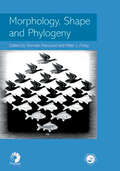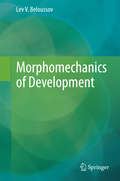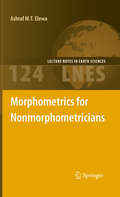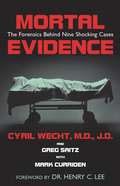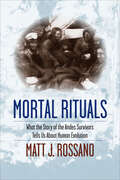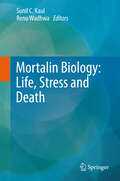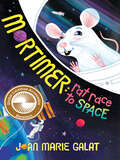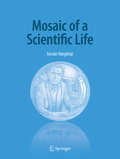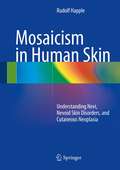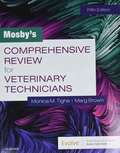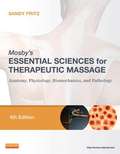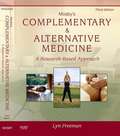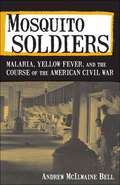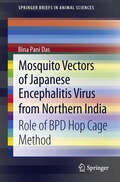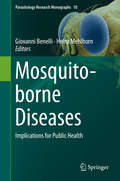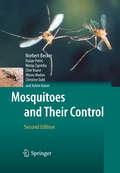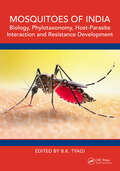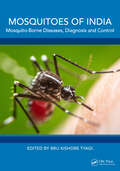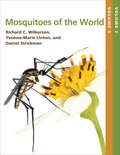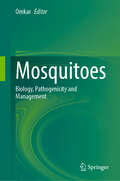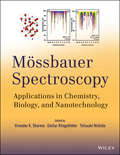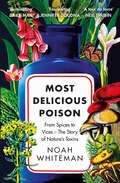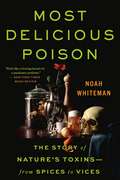- Table View
- List View
Morphology, Shape and Phylogeny (Systematics Association Special Volumes)
by Norman MacLeod Peter L. ForeyGenerally, biologists and mathematicians who study the shape and form of organisms have largely been working in isolation from those who work on evolutionary relationships through the analysis of common characteristics. Increasingly however, dialogue between the two communities is beginning to develop - but other than a handful of journal papers, there has been no formal, published discussion on this subject. This timely book summarises the interdisciplinary work that has taken place and will stimulate additional research into these topics. Any scientist working on evolutionary relationships will find this volume invaluable.
Morphomechanics of Development
by Lev V. BeloussovThis book outlines a unified theory of embryonic development, assuming morphogenesis to be a multi-level process including self-organizing steps while also obeying general laws. It is shown how molecular mechanisms generate mechanical forces, which in the long run lead to morphological changes. Questions such as how stress-mediated feedback acts at the cellular and supra-cellular levels and how executive and regulatory mechanisms are mutually dependent are addressed, while aspects of collective cell behavior and the morphogenesis of plants are also discussed. The morphomechanical approach employed in the book is based on the general principles of self-organization theory.
Morphometrics for Nonmorphometricians
by Ashraf M.T. ElewaMorphometrics is concerned with the study of variations and change in the form (size and shape) of organisms or objects adding a quantitative element to descriptions and thereby facilitating the comparison of different objects and organisms. This volume provides an introduction to morphometrics in a clear and simple way without recourse to complex mathematics and statistics. This introduction is followed by a series of case studies describing the variety of applications of morphometrics from paleontology and evolutionary ecology to archaeological artifacts analysis. This is followed by a presentation of future applications of morphometrics and state of the art software for analyzing and comparing shape.
Mortal Evidence: The Forensics Behind Nine Shocking Cases
by Cyril H. WechtA lifeless newborn baby is found discarded in a motel Dumpster. Authorities quickly arrest the infant's teenage parents, charging them with murder. Did Amy Grossberg and Brian Peterson, in fact, murder their own baby? Tammy Wynette died suddenly at a relatively young age, and yet no autopsy was performed? Was someone trying to hide the real cause of death? Did Sam Sheppard (later dubbed "The Fugitive" based on a television series) really kill his wife? And if not, who committed the murder?Things are not always as they appear, as world-renowned forensic pathologist Dr. Cyril Wecht shows in this riveting behind-the-scenes look at nine famous cases. In the nationally known baby case involving Amy Grossberg and Brian Peterson, Dr. Wecht reviews the evidence and comes to a startling conclusion. In fascinating detail, he demonstrates how the tools of forensic pathology often uncover murky, long-hidden secrets that crack seemingly unsolvable crimes. Writing in the first-person Dr. Wecht leads you into the heart of the investigation, focusing each chapter on a single engrossing drama. He reveals the most startling evidence that shows why JonBenet Ramsey's killer most likely came from within her home, why O.J. Simpson probably had an accomplice in the murder of Nicole Simpson and Ron Goldman, shocking revelations about Robert Berdella's grisly torture and sex-abuse crimes against young men, and many intriguing facts about other infamous cases.If you find the fictional plots of such dramas as C.S.I. exciting, you will be amazed by the true stories told by Dr. Wecht, with the help of two top-flight veteran reporters, Greg Saitz and Mark Curriden, in this amazing real-life thriller. As this intriguing page-turner proves, the science of forensic pathology has changed the face of detective work forever.
Mortal Rituals: What the Story of the Andes Survivors Tells Us About Human Evolution
by Matt J. RossanoA psychology professor examines what the survivors of the airplane crash hailed &“The Miracle of the Andes&” can show us about human evolution.On December 21, 1972, sixteen young survivors of Uruguayan Air Force Flight 571 were rescued after spending ten weeks stranded at the crash site of their plane, high in the remote Andes Mountains. The incident made international headlines and spawned several best-selling books, fueled partly by the fact that the young men had resorted to cannibalism to survive. Matt Rossano examines this story from an evolutionary perspective, weaving together findings and ideas from anthropology, psychology, religion, and cognitive science. During their ordeal, these young men broke &“civilized&” taboos to fend off starvation and abandoned &“civilized&” modes of thinking to maintain social unity and individual sanity. Through the power of ritual, the survivors were able to endure severe emotional and physical hardship. Rossano ties their story to our story, seeing in the mortal rituals of this struggle for survival a reflection of what it means to be human.&“[Rossano&’s] narrative describes a &“microcosm of human evolution,&” and I think this book will grab the interest of many readers―students as well as the general public―as it teaches essential facts about the way Homo sapiens evolved.&”—David Hicks, Stony Brook University and Clare College, Cambridge University &“[Rossano] masterfully weaves a moving contemporary drama with a compelling account of the evolutionary history of ritual and religion. An impressive accomplishment and a truly captivating read from start to finish.&”—Richard Sosis, University of Connecticut, cofounder and coeditor of Religion, Brain, & Behavior
Mortal Rituals: What the Story of the Andes Survivors Tells Us About Human Evolution
by Matt RossanoOn December 21, 1972, sixteen young survivors of Uruguayan Air Force Flight 571 were rescued after spending ten weeks stranded at the crash site of their plane, high in the remote Andes Mountains. The incident made international headlines and spawned several best-selling books, fueled partly by the fact that the young men had resorted to cannibalism to survive. Matt Rossano examines this story from an evolutionary perspective, weaving together findings and ideas from anthropology, psychology, religion, and cognitive science. During their ordeal, these young men broke "civilized" taboos to fend off starvation and abandoned "civilized" modes of thinking to maintain social unity and individual sanity. Through the power of ritual, the survivors were able to endure severe emotional and physical hardship. Rossano ties their story to our story, seeing in the mortal rituals of this struggle for survival a reflection of what it means to be human.
Mortalin Biology: Life, Stress and Death
by Renu Wadhwa Sunil C. KaulThe phrase "Life, stress and death" connects three terms, but is there a biological basis for that? Are there molecules that are essential to/or mediate these phenomena? This contributory volume "Mortalin Biology: Life, Stress and Death" is a remarkable compilation of the research outcomes on the stress protein mortalin, a member of heat shock 70 family of proteins. The book is unique as it describes mortalin playing essential role in life, stress response and death either from cancer, when it becomes hyperactive or from neuro-degeneration, when it becomes hypoactive. The book provides up-to-date knowledge on mortalin with respect to its discovery, structure, evolutionary conservation, function and signal transduction in different organisms in a simple, but most comprehensive way, that besides offering an enjoyable and in-depth reading, prompts the reader to ask further questions to explore this protein with new ideas, approaches and experiments. Twenty-one chapters by the world leaders on the specific areas of mortalin research throw light on its multi-functionality, potentials for biotechnology, diagnostics and therapeutic values. Avenues of mortalin biology, yet unexplored, hold immense promises for future, and reading this volume provides an easy, enthusiastic and energetic head-on start.
Mortimer: Rat Race to Space
by Joan Marie GalatA spot on the International Space Station (ISS) has opened up, and Mortimer, is not about to miss his chance to become an intergalactic space rat. And that’s just the first step in his master plan to prove that rats are much better suited than humans for a future mission to Mars. He packs his camera and prepares to take to the internet with his evidence of rat superiority. But when Mortimer’s schemes go awry, he is forced to face new truths about dreams, friendship, and choosing the right thing to do. Maybe not everything is a rat race.
Mosaic of a Scientific Life
by István HargittaiIn this book, István Hargittai, an internationally renowned physical chemist, narrates his life by introducing over forty personalities that played noteworthy roles in his career. The time span ranges from the Holocaust, which the author survived, through the periods of hard and softer dictatorships of Soviet-type socialism, and the current revival of an autocratic regime in Hungary. He overcame barriers to get a high school, then a university education. He received excellent training in Moscow and was active at Hungarian, American and other international scientific venues, and he has interacted with more Nobel laureates than anyone in the world.The chapters feature such famous contributors to world science as Francis Crick, Richard L. Garwin, Ronald J. Gillespie, Avram Hershko, George Klein, Paul Lauterbur and Peter Mansfield, Peter D. Lax, Paul Nurse, Yuval Ne’eman, George A. Olah, Guy Ourisson, Michael Polanyi, Andrei D. Sakharov, Albert Szent-Györgyi, Edward Teller, James D. Watson, and Eugene P. Wigner. The areas covered include chemistry, molecular biology, physics, materials science, and mathematics.“On the basis of Hargittai’s mosaic of his personal and scientific life, I could compose two further patterns. One would be the history of the twentieth century and the other the science history of the same time period.” From the Foreword by the late philosopher Agnes Heller, Goethe Medalist, Wallenberg Medalist, and Hannah Arendt Prize laureate
Mosaicism in Human Skin
by Rudolf HappleMosaicism is a powerful biologic concept, originally developed from studying plants and animals. All cutaneous neoplasms, both benign and malignant, reflect mosaicism, which is the necessary basis to explain numerous human skin disorders. For example, various mosaic patterns visualize the embryonic development of human skin and X-linked skin disorders explain why women live longer than men, and so on. This book presents, for the first time, a comprehensive overview on the strikingly manifold patterns and peculiarities of mosaic skin disorders. This reader-friendly structured and straightforward publication will help the dermatologist to understand the underlying molecular mechanisms of skin disorders in order to further improve the treatment outcome.
Mosby's Comprehensive Review for Veterinary Technicians
by Monica M. Tighe Marg BrownMaster critical concepts to succeed on your certification exam! Mosby’s Comprehensive Review for Veterinary Technicians, 5th Edition is the ideal review tool which reflects the most recent changes to the Veterinary Technician National Exam (VTNE). This edition features a user-friendly outline format that helps break down information visually for better comprehension of the material. Coverage reinforces key concepts in basic and clinical sciences, clinical applications, patient management and nutrition, anesthesia and pharmacology, medical and surgical nursing, and critical care, and information on pain management. Wide-ranging coverage includes dogs, cats, large animals, birds, reptiles, and laboratory animals. To ensure the most meaningful review, this new edition features a study mode on the Evolve site that includes 500 review questions and an exam mode with a computer-based testing environment similar to what you will encounter when taking the VTNE.
Mosby's Comprehensive Review of Radiography: The Complete Study Guide and Career Planner 6th Edition
by William J. CallawayA complete review for the Registry exam, Mosby's Comprehensive Review of Radiography: The Complete Study Guide and Career Planner, 6th Edition covers the five major subject areas of the ARRT exam in radiography. It is also an effective study guide for many radiography courses! Written in outline format, each review of a subject is followed by questions related specifically to that area. Two mock ARRT exams are included in the book.
Mosby's Essential Sciences for Therapeutic Massage: Anatomy, Physiology, Biomechanics, and Pathology (Fourth Edition)
by Sandy FritzThe fourth edition of this science essentials text for massage students features new full-color photos and illustrations along with an easy-to-read, conversational style that explains A&P concepts clearly. The book not only helps students learn the information they need to pass certification exams, but it also helps them see how scientific content applies to actual practice. This new edition also features a very enhanced Evolve resource package, along with new material on boosting your knowledge of nutrition and research two subjects of growing interest in the massage therapy profession.
Mosbys Complementary and Alternative Medicine: A Research-Based Approach
by Lynda W. FreemanDesigned in a true "textbook" format, this research-based book provides comprehensive and clinically-relevant coverage of complementary and alternative medicine. It covers the history, philosophy, and mechanisms of complementary medicine and alternative therapies, and includes a thorough review of the clinically controlled trials, indications, and contraindications of each therapy. Each chapter follows a consistent format with helpful features, such as: Why Read This Chapter, Chapter at a Glance, An Expert Speaks, review questions, critical thinking questions, clinical application questions, and more.
Mosquito Soldiers: Malaria, Yellow Fever, and the Course of the American Civil War
by Andrew Mcilwaine BellOf the 620,000 soldiers who perished during the American Civil War, the overwhelming majority died not from gunshot wounds or saber cuts, but from disease. And of the various maladies that plagued both armies, few were more pervasive than malaria -- a mosquito-borne illness that afflicted over 1.1 million soldiers serving in the Union army alone. Yellow fever, another disease transmitted by mosquitos, struck fear into the hearts of military planners who knew that "yellow jack" could wipe out an entire army in a matter of weeks. In this ground-breaking medical history, Andrew McIlwaine Bell explores the impact of these two terrifying mosquito-borne maladies on the major political and military events of the 1860s, revealing how deadly microorganisms carried by a tiny insect helped shape the course of the Civil War. Soldiers on both sides frequently complained about the annoying pests that fed on their blood, buzzed in their ears, invaded their tents, and generally contributed to the misery of army life. Little did they suspect that the South's large mosquito population operated as a sort of mercenary force, a third army, one that could work for or against either side depending on the circumstances. Malaria and yellow fever not only sickened thousands of Union and Confederate soldiers but also affected the timing and success of certain key military operations. Some commanders took seriously the threat posed by the southern disease environment and planned accordingly; others reacted only after large numbers of their men had already fallen ill. African American soldiers were ordered into areas deemed unhealthy for whites, and Confederate quartermasters watched helplessly as yellow fever plagued important port cities, disrupting critical supply chains and creating public panics.Bell also chronicles the effects of disease on the civilian population, describing how shortages of malarial medicine helped erode traditional gender roles by turning genteel southern women into smugglers. Southern urbanites learned the value of sanitation during the Union occupation only to endure the horror of new yellow fever outbreaks once it ended, and federal soldiers reintroduced malaria into non-immune northern areas after the war. Throughout his lively narrative, Bell reinterprets familiar Civil War battles and events from an epidemiological standpoint, providing a fascinating medical perspective on the war. By focusing on two specific diseases rather than a broad array of Civil War medical topics, Bell offers a clear understanding of how environmental factors serve as agents of change in history. Indeed, with Mosquito Soldiers, he proves that the course of the Civil War would have been far different had mosquito-borne illness not been part of the South's landscape in the 1860s.
Mosquito Vectors of Japanese Encephalitis Virus from Northern India
by Bina Pani DasJapanese Encephalitis (JE), a mosquito borne disease, is the leading cause of viral encephalitis in 14 Asian countries due to its epidemic potential, high case fatality rate and increased possibility of lifelong disability in patients who recover from this dreadful disease. In spite of seriousness of the disease, still only few books are available for ready reference. Hence, this book will be useful for students, entomologists, paramedical staff and vector control managers in public health. The objective of the book is to disseminate the knowledge gained by the author from ecological studies on JE vectors undertaken in 2 endemic and 2 non endemic areas of Northern India over a period of last 15 years (1998-2012) of research in the field of ecology of mosquito vectors of JE virus initially at National Institute of Communicable Diseases (Ministry of Health & Family Welfare, Government of India), Delhi and later at Jamia Millia Islamia, a Central University, Delhi, to anyone who wishes to curtail death of children due to this dreaded disease. Of the thousand suspected JE deaths in India annually, more than 75% is contributed by Northern India wherein disease transmission failed to be explained based on entomological evidence due to inadequate mosquito surveillance tool used in determining JE vector density. In order to overcome the above problem, Dr Bina Pani Das, the author of this book, developed "BPD hop cage method", a simple, cost effective, and operationally feasible surveillance tool specially designed to capture predominantly day resting adult Cx. tritaeniorhynchus mosquitoes, the principal JE vector species in the country from land and aquatic vegetation.
Mosquito-Borne Diseases: Implications for Public Health (Parasitology Research Monographs #10)
by Heinz Mehlhorn Giovanni Benelli<p>This book gathers contributions by 39 international specialists on well-known but neglected mosquito-borne diseases. The authors highlight pathogens that are increasingly being spread worldwide by various mosquito species, a situation worsened further by migration and tourism. <p>The book addresses significant agents of diseases like AIDS, dengue, Zika virus, malaria and even cancer, and the risk of transmission via mosquito-related vectors. In addition, it examines important means of preventing the outbreak of related diseases by using insecticides and/or repellents. <p>A particular focus is on the unique and sophisticated mouthparts of bloodsucking species, which allow them to feed on blood in an undisturbed manner, and by means of which agents of disease can enter potential human and animal hosts. <p>In brief, the book provides a broad range of information for a wide readership, including graduates, teachers and researchers in the fields of parasitology, virology, tropical medicine and microbiology, as well as practitioners and healthcare officials.</p>
Mosquitoes and Their Control
by Achim Kaiser Minoo Madon Norbert Becker Marija Zgomba Christine Dahl Clive Boase Dusan PetricMosquitoes and Their Control presents a wealth of information on the bionomics, systematics, ecology, research techniques and control of both nuisance and disease vector mosquitoes in an easily readable style, providing practical guidelines and important information for professionals and laymen alike. Ninety-two European species and more than 100 globally important vector and nuisance species are included in the book. Most of them, including all European species, are described in the fully illustrated identification keys, followed by a detailed description of the morphology, biology, distribution and medical importance of each species, including over 700 detailed drawings. Mosquitoes and Their Control includes: systematics and biology, medical significance, research techniques, illustrated identification keys for larval and adult mosquito general, morphology, ecology, and distribution of the species identified in the keys, biological, chemical, physical and genetic control of mosquitoes. Mosquitoes and Their Control is a valuable tool for vector ecologists, entomologists, and all those involved with mosquito control, biology, ecology, and systematics world-wide. It will especially benefit those professionals, scientists and students dealing with mosquitoes and their control on a day-to-day basis. Society as a whole stands to gain from improved, environmentally responsible mosquito management programs designed on the basis of a broader understanding of mosquitoes and their control, as provided in this enlightening book.
Mosquitoes of India: Biology, Phylotaxonomy, Host-Parasite Interaction and Resistance Development
by B. K. TyagiThis is an up-to-date and comprehensive handbook that presents a wealth of information on the different aspects of one of the largest dipterous family, Culicidae (Mosquitoes). India shares more than ten percent of the global mosquito fauna and this book provides an extensive inventory of extant taxa, along with a detailed description of the key identification features of medically important mosquitoes. This book illustrates updated information on insecticide-based mechanisms of resistance development in vectors and showcases varied host–parasite interactions. This authoritative account is a crucial reference source for mosquito-borne disease control and prevention. This book is meant for researchers, university students, medical entomologists, parasitologists, and public health professionals.
Mosquitoes of India: Mosquito-Borne Diseases, Diagnosis and Control
by Brij Kishore TyagiThis is an up-to-date and comprehensive handbook that presents a wealth of information on the different aspects of one of the largest dipterous family, Culicidae (mosquitoes). India shares more than 10% of the global mosquito fauna and some of the deadliest mosquito species occur in the country, implying that globally, India has always been in the forefront of research and control of such deadly and/or debilitating diseases as malaria, lymphatic filariasis, dengue, chikungunya, Zika, Japanese encephalitis, West Nile Virus, etc. This book illustrates updated information, including chemical, biological, herbal, and genetical, on the control of vectors, and showcases mosquito preponderance in the neighbouring countries. The book additionally deals with the biosafety principles in theory and practice, use of emerging science of artificial intelligence in mosquito identity and control, and, of course, consideration of mosquitoes in human psyche. This authoritative account is a crucial reference source for mosquito-borne disease control and prevention. This book is meant for researchers, university students, medical entomologists, parasitologists, and public health professionals.
Mosquitoes of the World
by Daniel Strickman Richard C. Wilkerson Yvonne-Marie LintonBiting multiple times on two, three, or more different hosts, it is no surprise that some species of mosquitoes have co-evolved with pathogens. For humans and other animals, the result has been some of the most challenging diseases known. It has been said that Anopheles gambiae, as the primary transmitter of malaria parasites to humans, is the most dangerous animal in the world. Certainly malaria has killed more people than all the wars that ever took place. Even now, despite drugs and mosquito control, malaria claims the lives of 405,000 per year. The vast majority of mosquito species are not involved in pathogen transmission to humans, but those that are make a huge impact on global health.In this two-volume set, three of the world's leading experts on mosquito disease, ecology, and systematics offer readers unique insights into the fascinating world of mosquitoes while illustrating their diagnostic morphological features in detail. Comprehensively addressing the natural diversity of mosquitoes, the book explains their life histories, bionomic traits, and the physiological and physical adaptations they evolved in response to ever-changing environmental conditions. Mosquitoes are one of the best-known groups of insects, making this book a great starting place for anyone who would like to understand entomology by knowing the details about a representative family.Volume One contains a review of the biology and diversity of mosquitoes. Biology is treated in the following chapters: • Evolution• Nomenclature• Distribution• Development• Dormancy• Mosquito Movement• Feeding and Nutrition• Excretion• Copulation and Insemination• Egg Development and OvipositionThe chapters on biology are followed by a well-illustrated summary of the characteristics of all 41 genera and of representative species of mosquitoes. This treatment of the morphological diversity of mosquitoes is accompanied by a glossary of all morphological terms used. Volume Two features• a long-awaited comprehensive mosquito taxonomic catalog detailing the current taxonomic and systematic status of all 3,698 valid species and subspecies, 41 genera, and 187 subgenera• a list of all taxa for definitive use of nomenclature• complete lists of species synonyms, distributions, key taxonomic works, and newly defined informal names• origins of scientific namesReaders will discover that some mosquitoes undertake courtship rituals, while others guard their eggs, feed solely on earthworms, or can survive as immatures under ice sheets or in salt-encrusted pools. Hundreds of drawings and high-resolution, close-up images illustrate the text. The most complete reference work on mosquitoes ever produced, Mosquitoes of the World is an unmatched resource for entomologists, public health professionals, epidemiologists, and reference libraries.
Mosquitoes: Biology, Pathogenicity and Management
by OmkarThis book provides a detailed overview of mosquitoes. It covers aspects of their origin, evolution, morphology, diversity, biology, and host finding and recognition. It also describes the behavior and rhythmicity of mosquitoes, their abiotic and biotic interactions, disease vectors and mechanism of disease transmission. Chapters describe mosquito-borne human diseases, mosquito-borne veterinary diseases, and management of mosquitoes. This book provides the readers with both the positive as well as the negative aspects of mosquitoes. It also discusses their use in research as a model organism and development of micro needles and their role in crop pollination. This book is useful for the students studying entomology, public health, medical and veterinary sciences, and applied life sciences. It is also a reference for those working in policy planning and vector management.
Mossbauer Spectroscopy
by Virender K. Sharma Gostar Klingelhofer Tetsuaki NishidaProviding a modern update of the field, Mossbauer Spectroscopy focuses on applications across a broad range of fields, including analysis of inorganic elements, nanoparticles, metalloenzymyes, biomolecules (including proteins), glass, coal, and iron. Ideal for a broad range of scientists, this one-stop reference presents advances gained in the field over past two decades, including a detailed theoretical description of Mossbauer spectroscopy, an extensive treatment of Mossbauer spectroscopy in applied areas, and challenges and future opportunities for the further development of this technique.
Most Delicious Poison: From Spices to Vices – The Story of Nature's Toxins
by Noah WhitemanA deadly secret lurks within our kitchens, medicine cabinets and gardens... Digitalis purpurea. The common foxglove. Vision blurs as blood pressure drops precipitously. The heartbeat slows until, finally, it stops. Atropa belladonna. Deadly nightshade. Eyes darken as strange shapes flutter across your vision. The heart begins to race and soon the entire body is overcome with convulsions. Papaver somniferum. The opium poppy. Pupils constrict to a pinprick as the senses dull. Gradually, breathing shudders to a halt. Scratch the surface of a coffee bean, a chilli flake or an apple seed and find a bevy of strange chemicals – biological weapons in a war raging unseen. Here, beetles, birds, bats and butterflies must navigate a minefield of specialised chemicals and biotoxins, each designed to maim and kill. And yet these chemicals, evolved to repel marauding insects and animals, have now become an integral part of our everyday lives. Some we use to greet our days (caffeine) and titillate our tongues (capsaicin), others to bend our minds (psilocybin) and take away our pains (opioids). Informed by his father&’s love of the natural world and his eventual spiral into the depths of addiction, evolutionary biologist Noah Whiteman explores how we came to use – and abuse – these chemicals. Delving into the mysterious origins of plant and fungal toxins, and their unique human history, Most Delicious Poison provides a kaleidoscopic tour of nature&’s most delectable and dangerous poisons. ***** 'Deeply researched and fascinating.' —JENNIFER DOUDNA, WINNER OF THE NOBEL PRIZE IN CHEMISTRY 'Magisterial, fascinating and gripping.' —NEIL SHUBIN, AUTHOR OF YOUR INNER FISH 'Exuberant, poignant and mind-blowing.' —DANIEL E. LIEBERMAN, AUTHOR OF EXERCISED
Most Delicious Poison: The Story of Nature's Toxins—From Spices to Vices
by Noah WhitemanAn evolutionary biologist tells the story of nature&’s toxins and why we are attracted—and addicted—to them, in this &“magisterial, fascinating, and gripping tour de force&” (Neil Shubin). A deadly secret lurks within our spice racks, medicine cabinets, backyard gardens, and private stashes. Scratch beneath the surface of a coffee bean, a red pepper flake, a poppy seed, a mold spore, a foxglove leaf, a magic-mushroom cap, a marijuana bud, or an apple seed, and we find a bevy of strange chemicals. We use these to greet our days (caffeine), titillate our tongues (capsaicin), recover from surgery (opioids), cure infections (penicillin), mend our hearts (digoxin), bend our minds (psilocybin), calm our nerves (CBD), and even kill our enemies (cyanide). But why do plants and fungi produce such chemicals? And how did we come to use and abuse some of them? Based on cutting-edge science in the fields of evolution, chemistry, and neuroscience, Most Delicious Poison reveals: The origins of toxins produced by plants, mushrooms, microbes, and even some animals The mechanisms that animals evolved to overcome them How a co-evolutionary arms race made its way into the human experience And much more This perpetual chemical war not only drove the diversification of life on Earth, but also is intimately tied to our own successes and failures. You will never look at a houseplant, mushroom, fruit, vegetable, or even the past five hundred years of human history the same way again.
